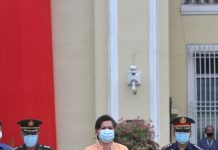The strong services sector sustained the economic growth of Davao Region last year despite the global crisis, the National Economic Development Authority (NEDA) regional office here reported.
NEDA 11 regional director Ma. Lourdes Lim, in her recent presentation of Davao region’s economic performance in 2009 and 2010 development outlook, said the services sector, particularly its trade and private services subsectors, properties market and having one of the best human resources in the country make the region the preferred destination for information and communication Technology (ICT).
She said agriculture also contributed to Davao region’s economic growth last year sustained by its higher fruit production, especially exportable bananas, mango, pineapple and durian.
Lim said NEDA 11, however, reported the need to improve the sufficiency level of the region’s staple foods, including rice and corn, which declined by nine percent from the 2008 level to 63.7 percent last year.
Investments, particularly in private construction, grew 46 percent in 2009 compared to 2008 level, she said.
Lim said the boom in property development strengthened the region’s position as preferred destination for trade and private services.
Despite the global economic slowdown, the region enjoyed favorable trade with global trading partners with value of exports posted at $544 million compared to import value of $406 million.
Meanwhile, employment was hit by the global crisis, dropping to 94 percent from 95.7 percent in 2008 level.
The drop was triggered by the displacement of domestic labor market of about 902 workers, although 536 of these retained their jobs through flexible working arrangements.
NEDA reported that 276 overseas Filipino workers (OFWs) were repatriated, mostly from Taiwan.
Government, however, controlled the impact to the employment sector through the Comprehensive Livelihood and Emergency Program (CLEEP). The program generated 19,942 jobs in 2009, which is higher than the number of displaced workers.
Tourism also suffered the brunt of the global crisis as it registered a mere one percent growth in the number of tourist arrivals during the first nine months of 2009 at 804,109 than the 2008 level of 799,729.
From the 804,109 visitors, 92.5 percent of whom were domestic travelers, the Davao region earned about P8.4 billion in tourist receipts.
In 2009, the region completed seven official development assisted (ODA) projects valued at P140 million.
Four projects which are ongoing and to be completed by 2010, include the Maramag-Bunawan 23 kilovolt (kV) transmission project, Kapalong-Talaingon-Boundary Bukidnon Road, Surigao-Davao Coastal Road (Boston-Manay section), and Davao del Sur-Sarangani coastal road.
NEDA 11 remains optimistic in the light of the recovery of some global economies.
Lim said NEDA 11 is projecting Davao region’s resiliency to continue this year as it targets a growth rate of 6.5 percent this year.
The region will enhance competitiveness in potential sectors, including ICT, mining, high value agribusiness, tourism and renewable energy.
It will also continue to draw strength from the ICT sector, particularly in BPO, describing it as the region’s “sunshine industry”.
Agriculture will continue to tap the halal market to boost its global competitiveness.
High investors’ confidence will remain in the areas of high tech equipment assembly, agri-business, e-learning, manufacturing of packaging materials, activated carbon, cold storage, and business process outsourcing.
On the other hand, the tourism sector will position itself as haven for local and foreign retirees.
The NEDA identified three challenges facing Davao region’s economic performance this year. These are the unresolved issue on aerial spraying in banana plantations, looming power shortage and high cost of domestic shipping. PNA
0 Comments
Oldest






